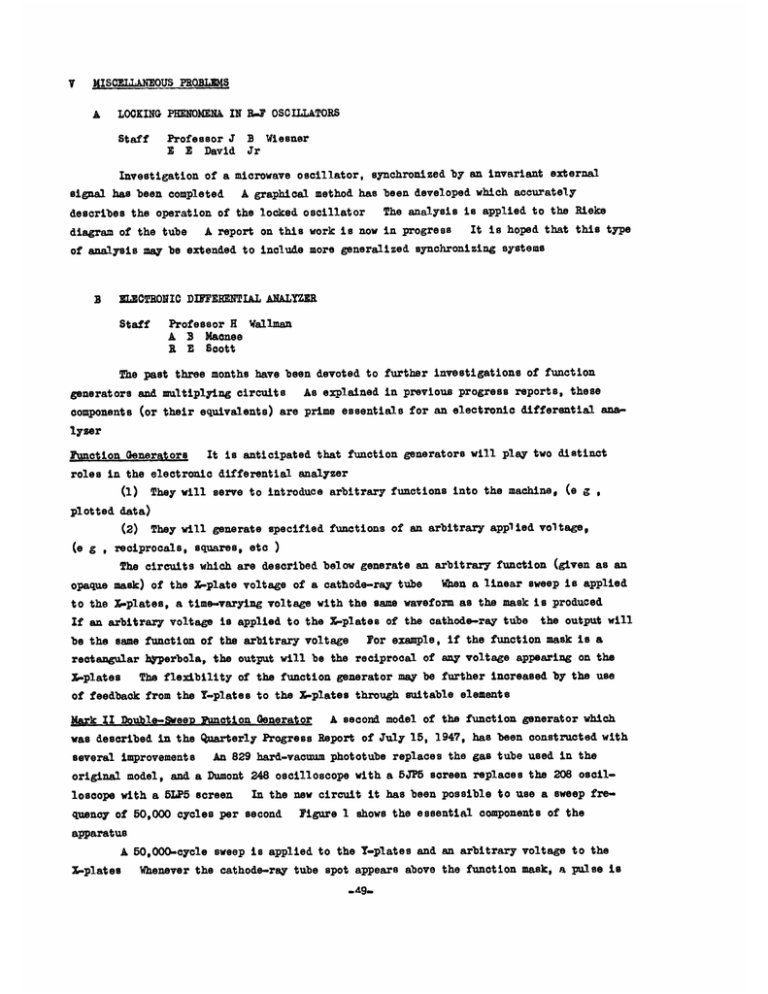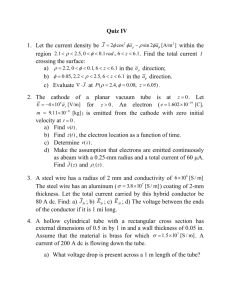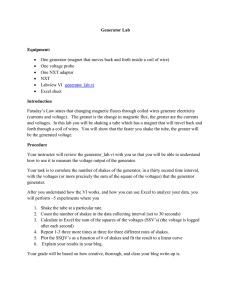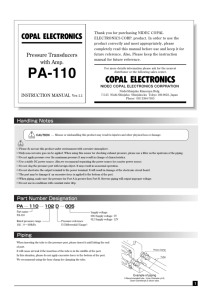V HISCINEO US PROBLEMS
advertisement

V HISCINEO US PROBLEMS A LOCKING PHENOMEN IN B-F OSCILLATORS Staff Professor J E E David B Wiesner Jr Investigation of a microwave oscillator, synchronized by an invariant external A graphical method has been developed which accurately signal has been completed The analysis is applied to the Rieke describes the operation of the locked oscillator It is hoped that this type A report on this work is now in progress of analysis may be extended to include more generalized synchronizing systems diagram of the tube 3 EL CTRONIC DIFFERENTIAL ANALYZER Staff Professor H Wallman A 3 Macnee R E Scott The past three months have been devoted to further investigations of function As explained in previous progress reports, these generators and multiplying circuits components (or their equivalents) are prime essentials for an electronic differential analyser Function Generators It is anticipated that function generators will play two distinct roles in the electronic differential analyzer They will serve to introduce arbitrary functions into the machine, (1) (e , plotted data) (2) They will generate specified functions of an arbitrary applied voltage, (e g , reciprocals, squares, etc ) The circuits which are described below generate an arbitrary function (given as an opaque mask) of the X-plate voltage of a cathode-ray tube When a linear sweep is applied to the &-plates, a time-varying voltage with the same waveform as the mask is produced If an arbitrary voltage is applied to the 1-plates of the cathode-ray tube the output will For example, if the function mask is a be the same function of the arbitrary voltage of any voltage appearing on the reciprocal be the will output rectangular hyperbola, the 1-plates The flexibility of the function generator may be further increased by the use of feedback from the Y-plates to the X-plates through suitable elements Mark II Double-Sweep Function Generator A second model of the function generator which was described in the Quarterly Progress Report of July 15, 1947, has been constructed with An 829 hard-vacuum phototube replaces the gas tube used in the several improvements original model, and a Dumont 248 oscilloscope with a 5JP5 screen replaces the 208 oscilloscope with a 5LP5 screen In the new circuit it has been possible to use a sweep fre- quency of 50,000 cycles per second Figure 1 shows the essential components of the apparatus A 50,000-cycle sweep is applied to the Y-plates and an arbitrary voltage to the Whenever the cathode-ray tube spot appears above the function mask, a pulse is 1-plates -49- MASK OUTPUT Figure 1 Mark II double-sweep function generator produced by the photocell which triggers the Y-sweep and returns it to zero envelope of the sweep wave follows the mask for any X-voltage detected Thas the When the output is it is the "mask" function of the X-voltage The Mark II circuit has a resolving time of about 50 tsec when the detector out- put is filtered to give about 1 per cent ripple This device is probably sufficiently good to be used as the input plotting table of the electronic differential analyzer It is probably too slow however, to be useful for more general applications including the generation of functions which has been discussed above the above has been tried stability difficulties A function generator system similar to It entails the use of d-c amplifiers and they lead to For this reason this system has been abandoned in favor of the almost identical system employing a pilot-carrier frequency A Continuous-Tracking Function Generator Fig however which is described below A second type of function generator is shown in 2 Figure 2 A continuous-tracking function generator The no-signal position of the cathode-ray tube electron beam is above the highest point of the function mask which is placed on the tube face The beam is intensitymodulated at a frequency of 200-500 ko/sec The modulated light from this beam is detected -50. by the photocell, the photocell output is amplified detected, and fed back to the vertical The beam is deflecting plates with a polarity which drives the electron beam downward thus forced downward to an equilibrium position of partial obscurity behind the opaque When a sweep voltage is applied to the horizontal deflecting plates, the function mask Because of the linear relationship beam is constrained to follow the function mask between the beam position and the vertical deflecting voltage, this feedback voltage This scheme provides d-c amplifier performance withbecomes the desired output function out the hum and drift problems charactertstic of high gain d-c amplifiers An experimental model of this system employing a 1-Me/sec bandpass amplifier This model operates successfully, but is having a 25 kc/sec bandwidth, has been tested A limited in its resolving time because of the narrowness of the amplifier passband second model which should be capable of better resolving times is now being built The second model of the target multiplier described in the last Target Multilier quarterly report has not yet been received from the tube shop Rectron-Velocity Multiplier Another multiplier electron beam for its operation, is shown in Fig which depends on the deflection of an 3 IOTOCELLS Electron-velocity mnltiplier Figure 3 Electrons leave the cathode-ra Passing through the first tube gun with a velocity along the s-axis of vo they are given a velocity component in pair of deflecting plates, the x-direction v = (e/m)d(/ o ) The beam next passes through an axial field B , which is gives the beam a velocity component in the y-direction which is -51- (1) proportional to approximately 3 This v Substituting from Eq (1) (0/2)d2v0 VO B (2) one has v This velocity = = (3)) (e/n(d.dldavA(s which is proportional to the product (Ez E), scheme as follows can be measured by a feedback The fluorescent screen of the cathode-ray tube is divided down the line y = 0 by an opaque partition and photocells are placed on either side is intensity-modulated at a carrier frequency The electron beam and the difference of the outputs of the two photocells is amplified by a carrier amplifier The output of this amplifier is detected by a phase-detector and fed back to a pair of horizontal deflecting plates in such a manner as to keep the net y-deflection zero portional to the product (z z) This feedback voltage is thus pro- Equations (2) and (3) are accurate for (eB/m)(dJ/vo)(oW9 Modifications of this scheme using all-electrostatic deflections are possible by replacing the axial coil with a pair of specially shaped deflecting plates Preliminary tests of this scheme using a Dumont 5LP5 cathode-ray tube and a low-pass amplifier feedback system indicate further work is C warranted ELECTRONIC POTENTIAL MAPPING Staff Dr Stanford Goldman An extended discussion of this project was given in the Quarterly Progress Report of July 15 1947 During the summer, quency filters work was started on the set of tunable uni-rontrol low-fre- for the preamplifier of the pickup tube The new scanning pickup tube has a3so just about been comleted D BROADBANDING 01 ARBITRARY IMPEDANCES Staff A paper Professor R M Fano "Theoretical Limitationson the Broadband Matching of Arbitrary Impedances" to be presented at the National Electronics Conference in Chicago in November has been sent to the Program Chairman The manuscript of the technical report (No completed -52- 41) on the same subject has been 3 ACTIVE NETWORKS Staff Professor E A Guillemin Manuel Cerrillo The present state of the theory of the synthesis of active networks is aJmost in which not much constructive work has been done reduced to a limited field Most of the solutions are restricted to very particular and specific cases and structures It is intended now to go somewhat deeper into the problem, in order to develop a more general and suitable theory of these systems The first steps have already been started, using the Lagrange problem in the Calculus of Variations as the fundamental mathematical tool Active networks are con- sidered here as a properly extended passive network in which some of the variables are The effect of vacuum tubes and other charac- subjected to a specific set of constraints teristics are introduced in this fashion In passive networks, the currents must be such as to keep a minimum the power dissipated in the system Special attention will be paid to the "sufficient condition" for the existence of now being made to find the proper electrical interpretation an extremun and an effort is F MATHEMATICAL PROBLEMS Staff R M Redheffer The last quarterly period has been spent on miscellaneous problems was suggested by Professor P Franklin Given a set of linear equations and the following suppose the unknowns are computed approximately upon substitution back into the equations are found to satisfy them within an error It is required to find an estimate for the error in the unknowns equation Ci for the i-th in terms of the substitution errors c i If the matrix of the system is A with I A 0 let A be the smallest characteristic value of AA the unknown error vector is It has been where M = not greater than M/X-, roved that the length of -Ci 2 is the length of the known error vector, and that a value this large can actually always be attained the sum of the squares of the coefficients in equations, then we have M/1-4 the equations and if <(M/4A)(T/n)n/2 This form is If T is there are n + 1 suitable for numerical ca3ca- lation The following problem was suggested by R a rectangular waveguide is easily calculated It L Kyh If connected to a source of potential, a transverse partition in the resulting d-o field is has been shown that the dot product of this field and the microwave field of suitable mode, will give the same value, when integrated over the cross section, as would be found with a uniform d-e field A report has been written on the interaction of antennas and dielectric sheets, preparatory to a journal article -53. V G SYNTHESIS OF OPTIMUM LINEAR SYSTEMS Staff Professor Y W Lee In order that Professor N Wiener's new communication engineering theory be made available to engineers, an exposition of this theory has been under preparation This is in great need since the theory is based upon new ideas and certain mathematical techniques A part of the expository writing has been which are unfamiliar to most engineers finished It should be mentioned here that Wiener's classical work covers not only the theory and design of optimum linear systems but also other problems of which the rigorous calcu- lation of the rate of transfer of information is outstanding on account of its fundamental importance in communication engineering Some experimental work will be started shortly -54-







